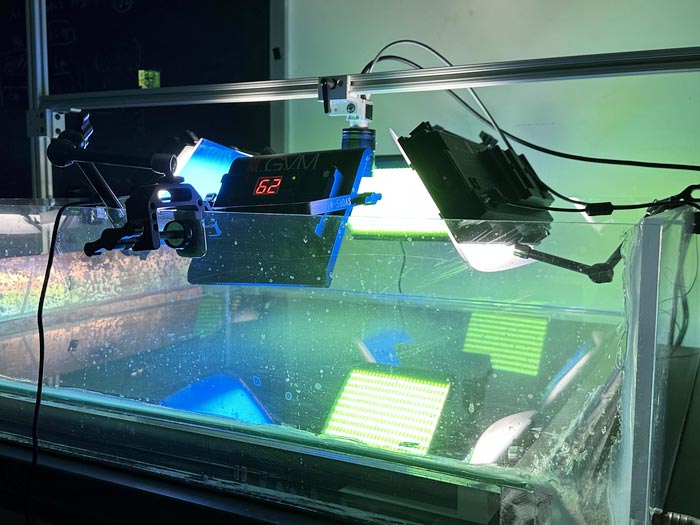Going with the flow

Quasi-two-dimensional laboratory flow system used by the Fang Research Group. In use, the system will be filled with salt water, using magnetic fields generated underneath to create turbulence.
Credit: University of Pittsburgh
Pitt engineer Lei Fang launches NSF-funded project to understand effect of active matter on transport barriers.
Imagine a school of fish swimming through the open water. The way the water flows affects how the school of fish moves and how much energy the fish expend; however, their movement affects the way the water flows, too.
The interactions at play here are part of the field of fluid dynamics, which is critical to engineering solutions like directing wastewater, or mapping and containing oceanic oil spills. Lei Fang, assistant professor of civil and environmental engineering at the University of Pittsburgh, received $361,476 from the National Science Foundation (NSF) to to model the effect of active matter on transport barriers that partition the flow domain into disconnected regions.
“Even though transport barriers are effective in understanding and controlling the transport of inactive material, that’s not the case for active matter,” explained Fang, who leads the Fang Research Group in the Swanson School of Engineering. “There is a critical need for a framework to model the interactions between active matter and transport barriers in the flow so that we can better understand the effect of overfishing on ocean currents, for example, or further develop drone technologies that can operate in swarms for environmental and urban monitoring.”
In order to build this framework, Fang will start on a smaller scale—much smaller.
Using a quasi-two-dimensional laboratory flow system, Fang will examine the effect of a group of brine shrimp—tiny zooplankton measuring less than a half-inch long—on transport barriers. He will use a light-guiding system to guide the brine shrimp through the system: a thin device filled with shallow water that produces chaotic and turbulent flows.
“On one hand, the fluid flow can affect the location of the shrimp, since they’re small enough to be carried by the flow,” said Fang. “But on the other hand, their paddling will modify the transport barriers. Once we better understand this effect, it will help engineers better model and control active matter in fluid in the future.”
The project, “Toward the Two-way Coupling between Active Matter and Transport Barriers,” began on Sept. 1, 2022.
Media Contact
Maggie Lindenberg
University of Pittsburgh
mlindenberg@pitt.edu
Original Source
All latest news from the category: Ecology, The Environment and Conservation
This complex theme deals primarily with interactions between organisms and the environmental factors that impact them, but to a greater extent between individual inanimate environmental factors.
innovations-report offers informative reports and articles on topics such as climate protection, landscape conservation, ecological systems, wildlife and nature parks and ecosystem efficiency and balance.
Newest articles

Future AR/VR controllers could be the palm of your hand
Carnegie Mellon University’s EgoTouch creates simple interfaces for virtual and augmented reality. The new generation of augmented and virtual reality controllers may not just fit in the palm of your…

‘Game changer’ in lithium extraction
Rice researchers develop novel electrochemical reactor. A team of Rice University researchers led by Lisa Biswal and Haotian Wang has developed an innovative electrochemical reactor to extract lithium from natural…

The blue-green sustainable proteins of seaweed
… may soon be on your plate. The protein in sea lettuce, a type of seaweed, is a promising complement to both meat and other current alternative protein sources. Seaweed…



